Chain saw use and training
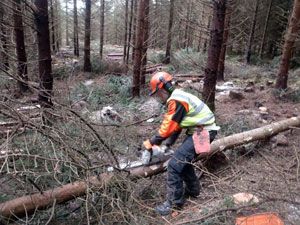
“I don’t need to attend a chainsaw course: I have been shown how to use one by someone who has been using a chainsaw for years, read a book, and have all the protective equipment required.” That’s what I thought until I attended a course with my son, who I had shown how to use a chainsaw safely.
I have been using a chainsaw for five years, for clearing overgrown tracks, and feeding the voracious wood burning stove that provides all my heat and hot water at home. My chainsaw usage couldn’t be all bad – I had survived five years use without any problems, and only one near miss, that wasn’t that near anyway.
However, my son and I decided that the time had come to go on a training course, to learn a few new techniques, how to sharpen a chain effectively, lose a few bad habits that I was sure we had adopted, but also to gain a formal qualification/certification in using a chainsaw: that is, legally required in order to undertake any paid work. Or so I thought.
So, we booked the last two remaining places on a course run by Phil Dunford, near Corwen in Wales. Phil’s track record as two-times winner of the British Chainsaw Championship, and seven times winner of the Welsh Treefelling Championship was one reason for the choice, but so was the excellent feedback from previous woodland buyers who had taken advantage of Woodlands.co.uk offer of £300 towards a course.
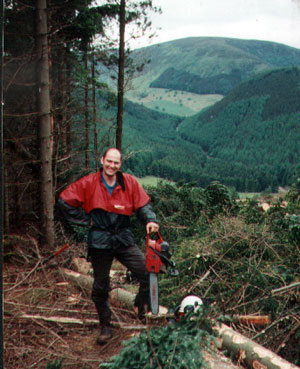 The course kicked off in the workshop where we learnt about risk assessment, chainsaw regulations, and chain sizes. Mercifully, Phil’s approach was to cover this as quickly as possible, and move on to the practical skills needed on a regular basis: how to sharpen a chain, maintain a guide bar, and replace a sprocket, starter spring, and starter cord.
The course kicked off in the workshop where we learnt about risk assessment, chainsaw regulations, and chain sizes. Mercifully, Phil’s approach was to cover this as quickly as possible, and move on to the practical skills needed on a regular basis: how to sharpen a chain, maintain a guide bar, and replace a sprocket, starter spring, and starter cord.
On the second day we were out in the forest, Clocaenog Forest, a Forestry Commission wood where harvesting was in progress, and we were able to carry out selective thinning work. Over the course of the next four days, Phil taught us how to start the chainsaw and check it is operating correctly, how to brash and buttress a tree in preparation for felling, and the types of felling cut for upright, forward leaning and backward leaning trees (standard, split level, dogs tooth, Danish), and then sned, crosscut and stack the timber. We had plenty of time to practice and perfect our techniques.
Finally, on the Friday evening and Saturday morning, in order to use the chainsaw for paid work and/or on other people’s land, we took the optional assessment for CS30 (Chainsaw Maintenance and Crosscutting) and CS31 (Felling trees up to 15 inch diameter). To our great relief, not only did we both pass, but honour was saved by both of us only being one point away from a maximum score!
Phil is a hugely experienced and enthusiastic chainsaw user, and clearly enjoys sharing his knowledge. I now know how to make sure a tree falls exactly where it is supposed to, and how to deal with it if it gets hung up. Not only did I discover that a lot of what other people had taught me was wrong, but also that the techniques taught were better, safer, and more reliable than what I had been doing before. I had been expecting the course to be useful: it turned out to be far more than that. The only thing I regret is that I left it so long before getting the training.
Comments are closed for this post.
Discussion
September
LEVEL 2 AWARD IN TREE CLIMBING AND RESCUE.
Ideal follow on from the professional chainsaw course, for those wishing to work in arboriculture. You will learn about knots, harnesses, safe climbing techniques and aerial rescue including pole rescue. This course is also recommended for ground staff in the industry, who must be able to rescue a climber in difficulty.
The course lasts 5 days, plus an assessment day. NPTC Assessment fee is payable in full, but the course fee will attract a 60% discount through eligibility for RDPE funding. Terms and conditions apply.
and ……………….
LEVEL 3 AWARD IN AERIAL CUTTING OF TREES & USING FREE-FALL TECHNIQUES.
Entry requirements- Level 2 award in tree climbing and rescue, a Level 2 award in crosscutting and maintenance and a Level 2 award in felling and processing trees up to 380mm.
This course will teach you about operating a chainsaw in a tree, using a rope and harness. The course will concentrate on the five basic requirements for NPTC assessment, as well as drawing on safe and accurate working practices. Chainsaws are provided but candidates must bring their own PPE.
The course lasts 3 days, plus an assessment day. The NPTC registration and assessment fee is payable in full but the course fee will attract a 60% discount through eligibility for RDPE funding. Terms and conditions apply.
Jane – did you run that course? I don’t live too far away & could be interested if you’ve postponed it….
Thanks to all of you with positive messages for me. I am based in Surrey, near Godalming, and have been thinking about hosting a course at my own woodland, using a qualified trainer. Anyone interested, post here. If I get enough people, mid January seems possible.
This company offers plenty of chainsaw training courses, don’t know if it would be of any help to anyone?
Jane, I took my chainsaw cert some years ago as part of a NVQ2 Forestry, after redundancy. Of course you can use a chainsaw – you might like to use a shorter bar than the fellas to cut down on the weight. I use a 13″ or 15″ on a Stihl. You can still cut down big stuff, as you use the techniques taught. A 2 guide bar felling cut is obviously a smaller tree with a 15″ bar than a 20″ one!
Just to mention that I recently went on this course as an almost complete amateur (only ever used a chainsaw to cross-cut firewood on a log horse). Was concerned that everyone would be a professional and I would look really silly. Couldn’t have been more wrong. Phil, the instructor, was fantastic – he made me feel welcome and put me completely at ease. It is well worth learning how to sharpen a chain and look after a chainsaw. After five days I now feel confident handling the saw and know how to fell fairly large trees safely. Would definitely recommend the course to anyone who isn’t sure.
Jane, it is definitely possible for women to safely handle a chainsaw. It is fair to say that physical strength is an advantage, but with proper training and technique you can safely work. Chainsaw choice is probably something to take advise on as a chainsaw you feel comfortably with will help no end.
Really good article! Can someone like me, a fit but not overly strong, late 40-something woodland enthusiast learn to handle a chainsaw? I am keen to acquire this new skill, but want to be safe! My husband and I have a small wood, and want to process modest amounts of wood for fuel and to manage the patch for biodiversity.
Jane
As a professional chainsaw user for over 30 years, climbing and groundwork I absolutely agree that training is vital. The right approach to safe working practice and risk assesment makes the job as safe as it can be and very enjoyable.
As the aforementioned ‘son’ in this article, I can strongly vouch for how informative and ‘necessary’ it is to take up this type of training.
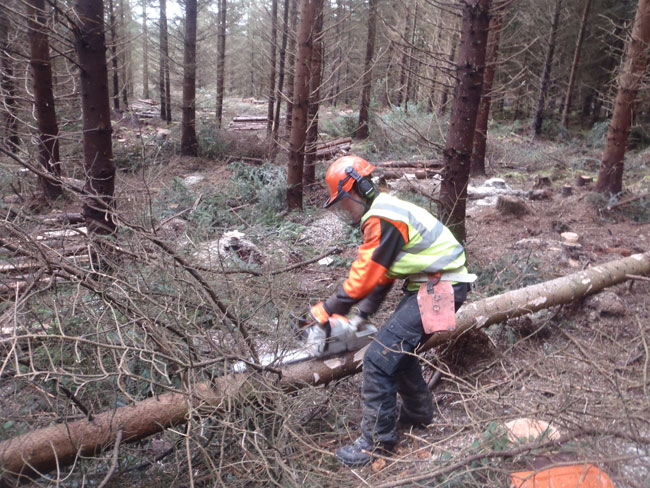
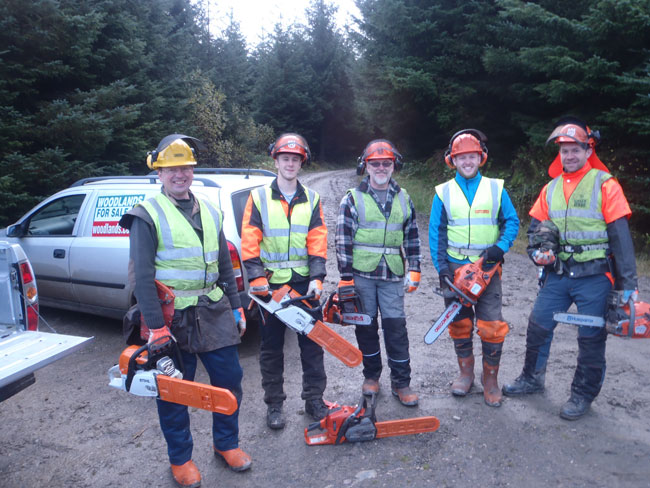
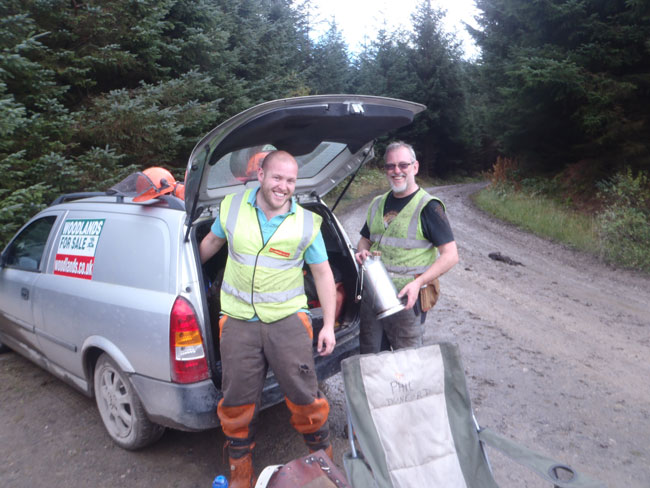

In answer to Liz – yes, we did it!
A very private affair.
Now my husband has the gear and the training, I am happy to let him do the lumberjack thing. I just write to-do lists!
Not planning on doing another any time soon.
Jane
3 July, 2013